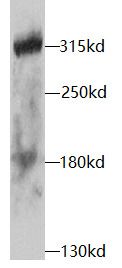Products
Notch1 antibody
Category:
Research Area:
- SPECIFICATIONS
- Product Name
- Notch1 antibody
- Catalogue No.
- FNab05798
- Size
- 100μg
- Form
- liquid
- Purification
- Immunogen affinity purified
- Purity
- ≥95% as determined by SDS-PAGE
- Clonality
- polyclonal
- Isotype
- IgG
- Storage
- PBS with 0.02% sodium azide and 50% glycerol pH 7.3, -20℃ for 12 months (Avoid repeated freeze / thaw cycles.)
Immunogen
- Immunogen
- Notch gene homolog 1 (Drosophila)
- Alternative Names
- AOS5 antibody, AOVD1 antibody, hN1 antibody, TAN1 antibody
- UniProt ID
- P46531
- Observed MW
- 300 kDa
Application
- Tested Applications
- ELISA, WB, IHC
- Recommended dilution
- WB: 1:500 - 1:2000; IHC: 1:100 - 1:200
Validated Images
 MCF7 cells were subjected to SDS PAGE followed by western blot with FNab05798(Notch1 antibody) at dilution of 1:1000
MCF7 cells were subjected to SDS PAGE followed by western blot with FNab05798(Notch1 antibody) at dilution of 1:1000
 Immunohistochemistry of paraffin-embedded rat spleen using FNab05798(Notch1 antibody) at dilution of 1:100
Immunohistochemistry of paraffin-embedded rat spleen using FNab05798(Notch1 antibody) at dilution of 1:100
- Background
- This gene encodes a member of the NOTCH family of proteins. Members of this Type I transmembrane protein family share structural characteristics including an extracellular domain consisting of multiple epidermal growth factor-like (EGF) repeats, and an intracellular domain consisting of multiple different domain types. Notch signaling is an evolutionarily conserved intercellular signaling pathway that regulates interactions between physically adjacent cells through binding of Notch family receptors to their cognate ligands. The encoded preproprotein is proteolytically processed in the trans-Golgi network to generate two polypeptide chains that heterodimerize to form the mature cell-surface receptor. This receptor plays a role in the development of numerous cell and tissue types. Mutations in this gene are associated with aortic valve disease, Adams-Oliver syndrome, T-cell acute lymphoblastic leukemia, chronic lymphocytic leukemia, and head and neck squamous cell carcinoma.



